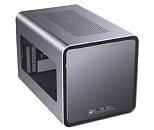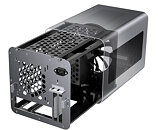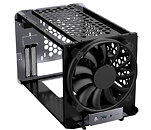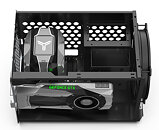Friday, July 3rd 2020
Jonsbo Unveils the V8 Cuboidal Mini-ITX Case
Jonsbo today unveiled the V8, a cuboid-shaped Mini-ITX case featuring a 2-piece slide out chassis design. The internal steel chassis of the case slides out intact of the outer aluminium-magnesium alloy body that has a silver/gray matte finish. The outer body features a floating front intake that conceals the case's main fan vent; and additional vents along the sides and top. The front intake features a large 200 mm fan that maintains positive air pressure inside the case; and mounts for two 140 mm/120 mm fans along the top, and one 140 mm/120 mm rear exhaust.
The Jonsbo V8 offers room for a Mini-ITX motherboard with room for full-height graphics cards up to 33 cm in length, and CPU coolers up to 19.5 cm in height. There are two expansion slots, however, there's enough room for a graphics card that's slightly thicker than 2 slots. An internal SFX/SFX-L PSU bay is wired to an AC receptacle extension at the rear. Stroage areas include two 3.5-inch bays and a 2.5-inch mount. Front panel connectivity includes one each of USB 3.2 type-C, USB 3.2 type-A, and HD audio jacks. The case measures 249.5 mm (W) x 390 mm (D) x 260MM (H). The company didn't reveal pricing.
The Jonsbo V8 offers room for a Mini-ITX motherboard with room for full-height graphics cards up to 33 cm in length, and CPU coolers up to 19.5 cm in height. There are two expansion slots, however, there's enough room for a graphics card that's slightly thicker than 2 slots. An internal SFX/SFX-L PSU bay is wired to an AC receptacle extension at the rear. Stroage areas include two 3.5-inch bays and a 2.5-inch mount. Front panel connectivity includes one each of USB 3.2 type-C, USB 3.2 type-A, and HD audio jacks. The case measures 249.5 mm (W) x 390 mm (D) x 260MM (H). The company didn't reveal pricing.





42 Comments on Jonsbo Unveils the V8 Cuboidal Mini-ITX Case
I think it would be amazing to have a slightly larger Dan A4 that supports just about every GPU, since the GPU is such an important part to get right and the biggest source of noise, if done wrong.
That nonsense stopped when the 500-series came out and the 'stock' RX580 jumped to 185W and the later RX590 arrived with a 225W TDP.
Look at TPU reviews of the 5700XT or GamersNexus 5700XT roundup of half a dozen of the 'budget' cards at MSRP. They're all basically different levels of insane oversized cooling and perfect examples of how far you can push the Navi10 GPU outside of it's comfort zone in terms of clocks/voltages. Most of them were beaten by the Gigabyte model that has far more modest cooling and dimensions, but better voltage/clock tuning.
I can only hope that Big Navi and Ampere aren't pushed to within an inch of their limits, because I hate large, expensive, hot and noisy GPUs.
There are a few recent threads I've been helping people out with here, downclocking and undervolting their Strix/Red Devil cards back to 'reference clocks and voltages' just to get the quieter, cooler card that their larger coolers are capable of. Hardware Unboxed has a nice roundup of the MSRP +/-$10 5700XT cards, all of which have vastly superior cooling to the reference blower but many of them are squandering that extra size and cooling area on poor tuning, higher voltages and higher clocks. The original TUF is included in that roundup as an "absolute failure, do not buy"
The thing with current AMD silicon at least is that the reference cards and voltages are already well past the sweet spot so these factory overclocked models with huge coolers, 2GHz clocks and extreme voltages are so aggressive that the extra power draw is a bigger step over the reference design than their enlarged, improved coolers. Take the 5700XT Strix for example: It has the best cooler but it also has a 50W higher power draw over the reference card for a meagre 7% core clock increase - which results in a real-world performance gain of around 3%. 3% more performance for 30% more power is criminally wasteful when these things are already the noise/power/cooling bottlenecks for most systems.
The Strix isn't the only culprit - the THICC II, Taichi and Nitro+ all draw far too much power for their puny overclocks that result in just 1-2fps more than the reference card. At least the Nitro+ has incredible cooling and can overcome the efficiency defecit with brute force - the the other two not so much.
I'm sure I'm sounding like a broken record at this point, but without even trying to brag about it I can "fix" the unimpressive reference card with a simple tune-up. It's been a while since I looked now but I think the "daily driver" profile is 1666MHz at 875mv, resulting in a sub-120W power draw. Benchmarks tell me that I'm getting 92-93% the performance for 50-60% of the default power draw. That means that I've achieved a 60-70% performance/Watt improvement simply by giving up those last few percent that frankly don't make a huge difference. If my game was for some reason going to drop down to 40fps at stock settings, it's going to hit 37fps now with my underclocked, undervolted card. Neither of those scenarios are great, so I'd rather just drop the settings/resolution to accommodate much better framerates. In silence. At 110W. At MSRP. Without using an over-height, over-long, extra-wide 3-slot cooler.
That's why I bought a slightly bigger case not long ago instead of the Dans, but I was really considering it for a long time. It just also still happens to be way easier to cool the system in a bigger case, so there's that advantage, too. Of course, if done right, I think a smaller case could also have all these advantages.
www.scan.co.uk/products/fractal-design-focus-g-mini-black-windowed-micro-atx-tower-case
www.scan.co.uk/products/silverstone-sst-ps15w-g-precision-mini-tower-micro-atxcomputer-case-tempered-glass-white-2xusb30
At the same ~25L volume but actually a smaller footprint (slightly more height), they are even more flexibility than the TU150 in terms of airflow space for the GPU. There are more decent mATX motherboards than there are mITX motherboards on both Intel and AMD platforms, too. Most of the ITX boards are overpriced compromises IMO - I'd rather have two M.2 slots and proper VRM cooling for the CPU than shave the board down that small for a dGPU build - Lets face it, an ITX board with a 3-slot GPU is realistically as wide/tall as an mATX board anyway!
In saying that, I'm a sucker for brushed aluminium. That was the best thing about my old LianLi PC-A04 :)
There's also probably something to be said about the Jonsbo UMX3. It's also ~25 liters and it fits the same GPU length, 3-slot cards as the Lian Li TU150 and just a slightly smaller CPU-air-cooler, but also makes that up by taking up much less desk-space like the SilverStone. It looks amazing in my opinion in the version without the acrylic window (haven't seen the windowed version in person though). But it's probably the most direct competitor to the Lian Li in looks, features and the price is almost identical with less than a dollar difference in the EU.
But I agree, the SilverStone Precision PS15 is probably the clear winner in terms of pure function. Just that I'm a sucker for brushed aluminium as well. It's kind of hard not to go with the much better looking case sometimes. :rolleyes:
I guess then, now I hope they make that SilverStone in brushed aluminium some day. Their new cases at least do seem to be going in that direction. So I'll have my fingers crossed.
It is really beautiful, so much that my wife says it all the time. Build quality is excellent, aluminum is thick and has nice finish, no sharp edges. Front fan is decently quiet, and sits about 1cm away from front panel. How much air does it push, don't know, cannot test it with case closed. but temps are overall similar to my previous case, inwin101. Gpu can easily pull air through mesh on the side, as well as psu on the opposite side.
There is a lot of room for gpu, and cpu air-cooler but there is not a lot of space to hide your cables. Took me two days to build, arrange and hide everything. Hopefully someday I can get 2TB m.2 and remove hdd cage and a lot of cables it holds right now.